If You Wish to Upload Your List of Activities
10. Project Schedule Planning
In order to develop our schedule, we first need to ascertain the activities, sequence them in the right order, judge the resources needed, and guess the time it will take to complete the tasks.
Defining Activities
The activity definition process is a further breakdown of the work bundle elements of the WBS. It documents the specific activities needed to fulfill the deliverables detailed in the WBS. These activities are not the deliverables themselves but the individual units of work that must be completed to fulfill the deliverables. Activity definition uses everything nosotros already know about the project to divide the piece of work into activities that tin be estimated. Y'all might want to look at all the lessons learned from similar projects your visitor has washed to become a practiced idea of what you need to practice on the current one.
Practiced judgment in the form of projection team members with prior feel developing project telescopic statements and WBS can help you define activities. If you are asked to manage a projection in a new domain, you might as well utilise experts in that particular field to assistance ascertain tasks so you can empathise what activities are going to be involved. You may want to create an activeness list and and so have the expert review information technology and suggest changes. Alternatively, you could involve the expert from the very outset and enquire to have an action definition conversation with him or her before even making your first draft of the listing.
Sometimes you start a project without knowing a lot about the work that you'll be doing later. Rolling-wave planning lets yous plan and schedule just the portion that y'all know enough about to programme well. When yous don't know enough almost a project, you can use placeholders for the unknown portions until you know more. These are extra items that are put at high levels in the WBS to permit y'all to programme for the unknown.
A Case Study
Susan and Steve take decided to tie the knot, but they don't take much time to plan their wedding. They want the large day to be unforgettable. They want to invite many people and provide a corking time. They've ever dreamed of a June hymeneals, only it'southward already Jan. Merely thinking about all of the details involved is overwhelming. Susan has been dreaming of the big day since she was 12, but it seems that there's and then petty fourth dimension for all the tasks to be completed. When they were choosing the newspaper for the invitations, the couple realized that they needed help.
Susan: Steve, we need some help.
Steve: Don't worry. My sister'due south hymeneals planner was groovy. Let me give her a call. [Steve calls the wedding planner Sally.]
Wedding ceremony Planner: Hullo, Susan and Steve.
Steve: Nosotros want everything to be perfect.
Susan: In that location is then much to do! Invitations, food, guests, and music.
Steve: Oh no, we haven't even booked a place!
Susan: And it has to exist done right. We can't print the invitations until we accept the menu planned. Nosotros can't practice the seating arrangements until we accept the RSVPs. Nosotros aren't sure what kind of band to go for the reception, or should it exist a DJ? We're but overwhelmed.
Steve: My sis said yous really saved her hymeneals. I know she gave y'all over a year to plan. Only I've always dreamed of a June wedding, and I'm not willing to give that up. I know information technology's belatedly, but Emerge, can you assist us?
Wedding Planner: Take it piece of cake. I've got information technology under command. We've a lot of people and activities to become nether command. You actually should have called six months ago, but nosotros'll still make this nuptials happen on fourth dimension.
Much work has to be done before June. First, Sally figures out what work needs to be washed. She starts to put together a to-do listing:
- Invitations
- Flowers
- Hymeneals cake
- Dinner menu
- Ring
Since many dissimilar people are involved in the making of the hymeneals, it takes much planning to coordinate all the work in the right order past the right people at the correct time. Initially, Sally was worried that she didn't have enough time to brand certain that everything would be done properly. However, she knew that she had some powerful time management tools on her side when she took the task, and these tools would help her to synchronize all the required tasks.
To get started, Emerge arranged all the activities in a piece of work breakdown structure. The next exercise presents part of the WBS Sally made for the hymeneals.
Arrange the following activities into the WBS (Effigy 10.1) to show how the work items decompose into activities.
- Shop for shoes
- Create guest list
- Have the tailoring and fitting done
- Shop for apparel
- Find caterer
- Cater the hymeneals
- Wait for RSVPs
- Mail service the invitations
- Finalize the card
- Print the invitations
- Choose the bouquet
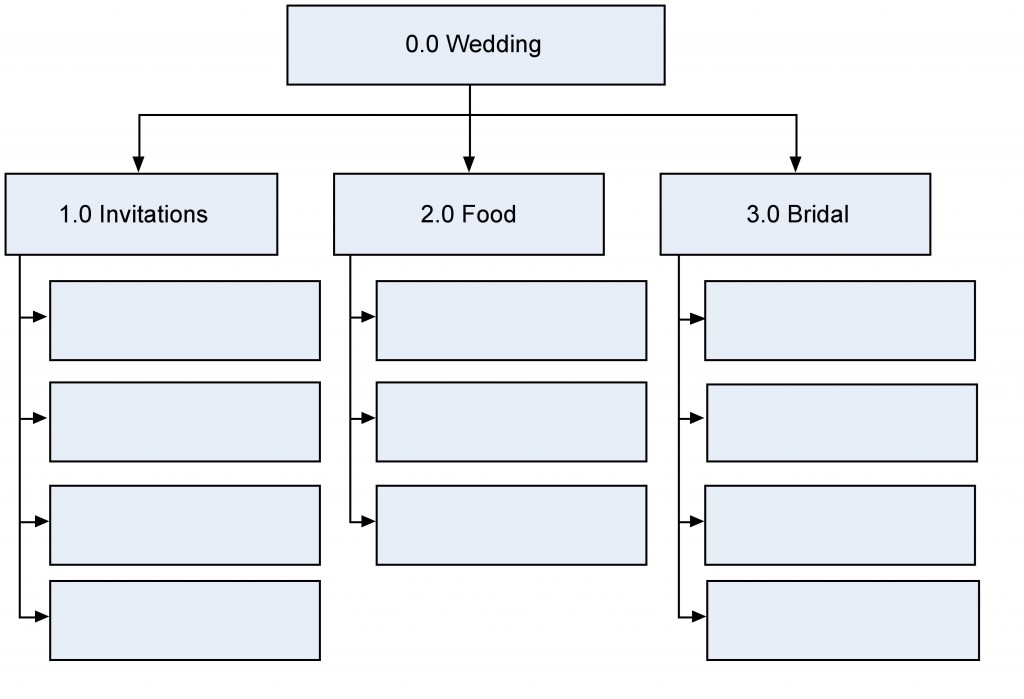
Solution to Exercise:
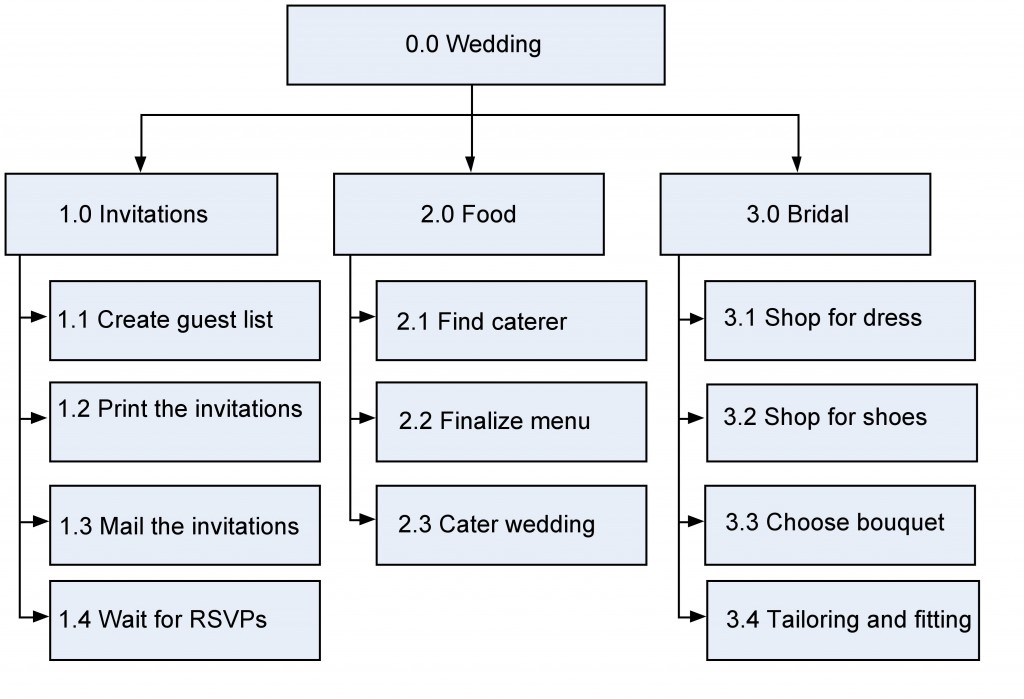
Action List
Now that the activity definitions for the work packages have been completed, the next job is to complete the action list. The project action list is a list of everything that needs to exist washed to consummate your project, including all the activities that must exist accomplished to deliver each work bundle. Next you want to define the activity attributes. Here'southward where the description of each activity is kept. It includes all the information yous need to figure out plus the order of the piece of work. Any predecessor activities, successor activities, or constraints should be listed in the attributes forth with descriptions and any other information nearly resources or time that y'all need for planning. The three main kinds of predecessors are end-to-outset (FS), beginning-to-start (SS), and terminate-to-terminate (FF). The most common kind of predecessor is the finish-to-start. Information technology ways that one chore needs to be completed earlier another one can start. When you think of predecessors, this is what y'all ordinarily think of; one matter needs to stop before the next tin can begin. Information technology'due south called finish-to-offset because the first activity's finish leads into the 2nd activity's start (Figure 10.three).

The commencement-to-showtime predecessor is a petty less common, but sometimes you need to coordinate activities so they begin at the same fourth dimension (Effigy 10.4).
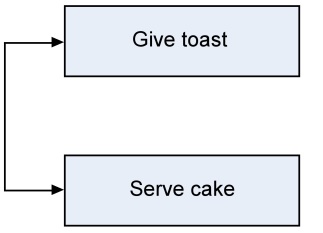
The finish-to-finish predecessor shows activities that finish at the same time (Effigy ten.5).
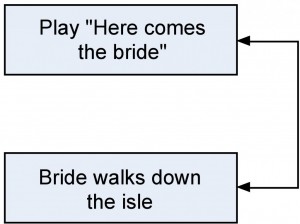
It is possible to have start-to-cease (SF) predecessors. This happens when activities require that another task be started before the successor task can finish. An example might be that the musicians cannot finish playing until the guests have started leaving the ceremony. In improver, there are some item types of predecessors that must be considered.
External Predecessors
Sometimes your project will depend on things outside the piece of work you're doing. For the wedding, we are depending on the wedding party before united states of america to be out of the reception hall in time for the states to decorate. The ornamentation of the reception hall then depends on that as an external predecessor.
Discretionary Predecessors
These are usually process- or procedure-driven or best-exercise techniques based on past experience. In the wedding ceremony example, Steve and Susan desire the bridesmaids to arrive at the reception before the couple arrives. There's no necessity; it is just a matter of preference.
Mandatory Predecessors
You can't accost an invitation that hasn't been printed yet. And so printing invitations is a mandatory predecessor for addressing them. Mandatory predecessors are the kinds that take to exist just because of the nature of the piece of work.
Leads and Lags
Sometimes you demand to requite some extra time betwixt activities. Lag time is when you purposefully put a filibuster between the predecessor task and the successor. For example, when the bride and her father trip the light fantastic toe, the others await awhile before they join them (Figure ten.6).
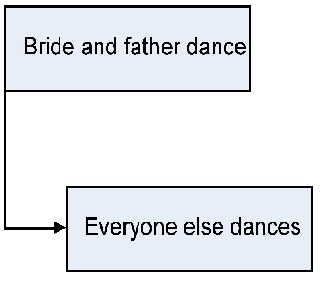
Lead time is when you give a successor task some time to get started before the predecessor finishes (Figure 10.7). So you might want the caterer preparing dessert an hour before everybody is eating dinner.
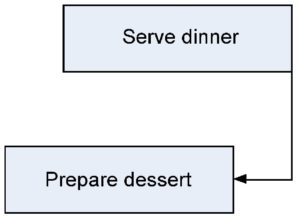
Milestones
All of the important checkpoints of your project are tracked as milestones. Some of them could be listed in your contract equally requirements of successful completion; some could simply be significant points in the project that you want to keep track of. The milestone list needs to let everyone know which milestones are required and which are not.
Some milestones for Susan and Steve'south wedding might be:
- Invitations sent
- Carte finalized
- Location booked
- Bridesmaids' dresses fitted
Equally you effigy out which activities volition need to be washed, you may realize that the scope needs to change. When that happens, you need to create a alter asking and send it through the modify command system.
Some things that could become wrong:
Hymeneals Planner: We merely got the programs dorsum from the printer and they're all wrong.
Steve: The quartet cancelled. They had some other wedding ceremony that twenty-four hours.
Susan: Aunt Jane is supposed to sing at the service, but after what happened at her uncle's funeral, I retrieve I want someone else to practise information technology.
Steve: Should we really have a pan flute player? I'm starting time to think information technology might exist overkill.
Susan: Apparently! Possibly nosotros should hold off on printing the invitations until these things are worked out.
Hymeneals Planner: OK, let's think about exactly how we desire to practise this. I think we need to exist certain about how we want the service to become before we practice any more printing.
The Activity Sequencing Process
At present that we know what we have to exercise to make the wedding a success, we demand to focus on the order of the work. Sally sat down with all of the activities she had defined for the wedding ceremony and decided to effigy out exactly how they needed to happen. That's where she used the activeness sequencing process.
The activity attribute list Sally created had most of the predecessors and successors necessary written in it. This is where she thought of what comes commencement, 2nd, third, etc. Emerge's milestone list had major pieces of work written down, and at that place were a couple of changes to the scope she had discovered along the way that were canonical and ready to go.
| Case milestone list: Steve and Susan had asked that the invitations be printed at least three months in advance to be sure that anybody had time to RSVP. That's a milestone on Emerge's list. |
| Example modify asking: When Sally realized that Steve and Susan were going to demand another limo to take the bridesmaids to the reception hall, she put that change through change control, including running everything past Susan'due south mother, and it was approved. |
Creating the Gantt Nautical chart
A Gantt nautical chart is a type of bar chart, developed by Henry Gantt, that illustrates a project schedule. Gantt charts are piece of cake to read and are commonly used to display schedule activities. These charts display the start and finish dates of the terminal elements and summary elements of a project. Final elements and summary elements comprise the piece of work breakdown structure of the project. Some Gantt charts too testify the dependency relationships (i.eastward., precedence network) between activities.
Gantt charts show all the key stages of a projection and their duration as a bar chart, with the time scale across the peak. The primal stages are placed on the bar chart in sequence, starting in the top left corner and catastrophe in the lesser right corner (Effigy 10.eight). A Gantt chart can be drawn rapidly and easily and is often the first tool a project manager uses to provide a rough estimate of the time that information technology will take to complete the key tasks. Sometimes information technology is useful to start with the target deadline for completion of the whole project, because information technology is soon apparent if the time scale is too short or unnecessarily long. The detailed Gantt nautical chart is normally constructed afterwards the main objectives take been determined.
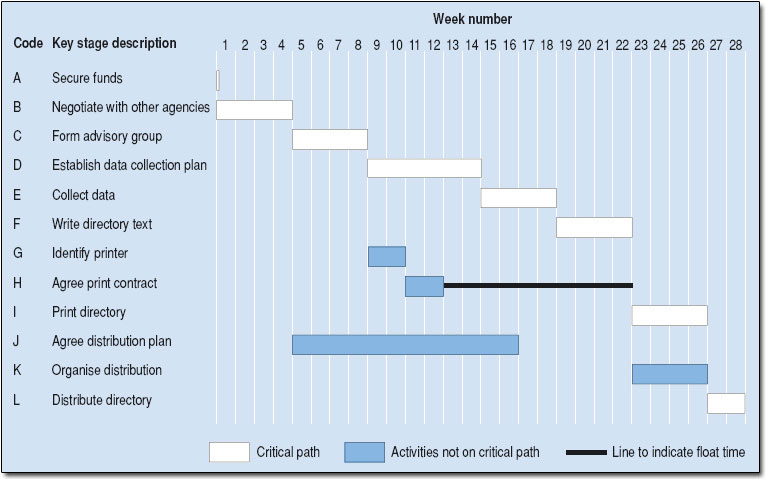
In this example in Figure 10.8, primal phase M (Organize distribution) starts at week 23 so that its end point coincides with key phase L (Distribute directory). However, K could begin as early equally week 17, as soon as key stage J is completed. Cardinal stage K is therefore said to have "slack." Cardinal stage H (Agree impress contract) has been placed to finish at week 12. However, it could cease as belatedly as week 22, because key stage I (Print directory) does not begin until week 23. Key stage H is therefore said to have "float." Float time can be indicated on the chart by adding a line ahead of the bar to the latest possible end point. Slack and bladder bear witness you where there is flexibility in the schedule, and this tin can be useful when you need to proceeds time one time the project is up and running.
You can add other data to a Gantt chart, for instance:
- Milestones could be indicated past using a symbol such as a diamond or triangle.
- Projection meetings could be indicated by some other symbol such as a circle.
- Reviews of progress could exist indicated past a square.
For a circuitous project, you may decide to produce a carve up Gantt chart for each of the key stages. If y'all do this shortly before each key stage begins, you lot will be able to take whatever last-minute eventualities into account. These charts provide a useful tool for monitoring and control every bit the project progresses.
Gantt charts are relatively easy to draw by mitt, merely this doesn't offering the same level of flexibility during monitoring that y'all would go from a software bundle. Various programs are available to assist project managers in scheduling and control. Once the information have been entered, a program helps you lot to piece of work on "what if" scenarios, showing what might happen if a primal stage is delayed or speeded up. This is more than difficult if you are working manually.
Creating the Network Diagram
Many projection managers utilize network diagrams when scheduling a projection. The network diagram is a way to visualize the interrelationships of project activities. Network diagrams provide a graphical view of the tasks and how they chronicle to i another. The tasks in the network are the piece of work packages of the WBS. All of the WBS tasks must be included in the network because they accept to be accounted for in the schedule. Leaving even one chore out of the network could change the overall schedule duration, estimated costs, and resources allotment commitments.
The first step is to adapt the tasks from your WBS into a sequence. Some tasks tin be accomplished at whatever time throughout the projection where other tasks depend on input from another task or are constrained by time or resource.
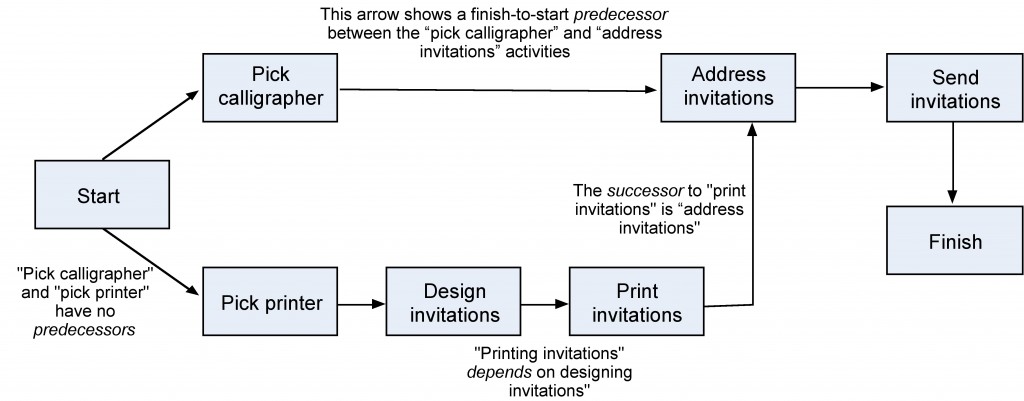
The WBS is non a schedule, merely it is the basis for information technology. The network diagram is a schedule just is used primarily to identify cardinal scheduling information that ultimately goes into convenient schedule formats, such as milestone and Gantt charts.
The network diagram provides important data to the projection team. It provides data about how the tasks are related (Figure 10.nine), where the risk points are in the schedule, how long it will take as currently planned to terminate the project, and when each task needs to begin and terminate.
In our hymeneals planner example, Sally would look for relationships between tasks and determine what can be done in parallel and what activities demand to look for others to complete. As an example, Effigy ten.ten shows how the activities involved in producing the invitations depend on one another. Showing the activities in rectangles and their relationships equally arrows is called a precedence diagramming method (PDM). This kind of diagram is also chosen an activity-on-node (AON) diagram.
Another way to testify how tasks chronicle is with the activity-on-arrow (AOA) diagram. Although AON is more commonly used and is supported by all project management programs, PERT is the all-time-known AOA-type diagram and is the historical basis of all network diagramming. The main difference is the AOA diagram is traditionally fatigued using circles as the nodes, with nodes representing the outset and catastrophe points of the arrows or tasks. In the AOA network, the arrows represent the activities or tasks (Effigy x.11).
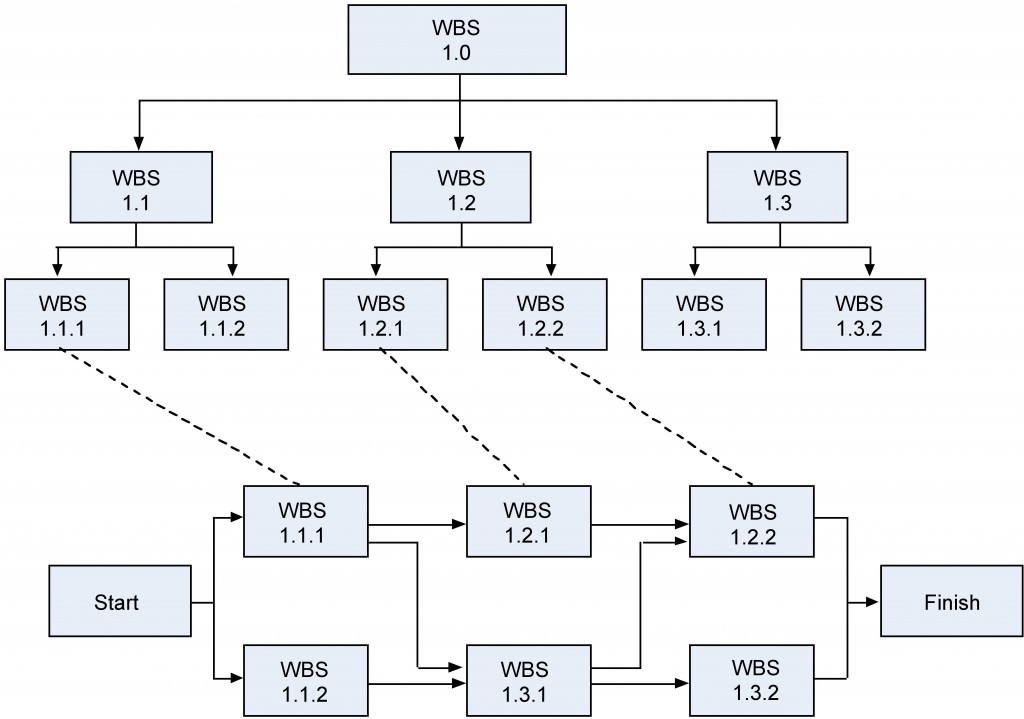
All network diagrams have the advantages of showing task interdependencies, start and end times, and the critical path (the longest path through the network) just the AOA network diagram has some disadvantages that limit the use of the method.
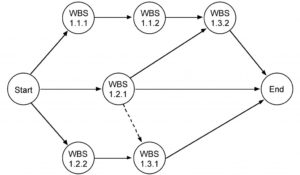
The three major disadvantages of the AOA method are:
- The AOA network tin can but evidence finish-to-start relationships. Information technology is not possible to show pb and lag except by adding or subtracting time, which makes project tracking hard.
- There are instances when dummy activities can occur in an AOA network. Dummy activities are activities that bear witness the dependency of 1 task on other tasks but for other than technical reasons. For example, ane task may depend on another because it would be more price constructive to use the same resources for the ii; otherwise the two tasks could exist accomplished in parallel. Dummy activities do not have durations associated with them. They just show that a task has some kind of dependence on another task.
- AOA diagrams are not as widely used as AON diagrams only considering the latter are somewhat simpler to use, and all projection management software programs can accommodate AON networks, whereas not all tin accommodate AOA networks.
The Critical Path
The critical path describes the sequence of tasks that would enable the project to be completed in the shortest possible time. It is based on the idea that some tasks must be completed earlier others tin can begin. A critical path diagram is a useful tool for scheduling dependencies and decision-making a project. In order to identify the critical path, the length of time that each task will take must be calculated.
Let's take a expect at an example. The length of time in weeks for each cardinal stage is estimated:
| Key stage | Estimated time in weeks |
|---|---|
| A. Secure funds | 0 |
| B. Negotiate with other agencies | iv |
| C. Form informational grouping | 4 |
| D. Institute data collection program | vi |
| E. Collect data | 4 |
| F. Write directory text | iv |
| G. Identify printer | 2 |
| H. Agree impress contract | 2 |
| I. Print directory | 4 |
| J. Agree distribution program | 12 |
| K. Organize distribution | four |
| L. Distribute directory | two |
We have given the central phase "Secure funds" an estimated time of zero weeks because the projection cannot offset without the availability of some funding, although estimates would provide detail at a later on phase. The stages tin now be lined upward to produce a network diagram that shows that there are three paths from first to stop and that the lines making up each path have a minimum duration (Figure 10.12).
If we now trace each of the possible paths to "Distribute directory" (the finishing point), taking dependencies into account, the road that has the longest duration is known equally the critical path. This is the minimum fourth dimension in which it volition be possible to complete the project.

In this case, the critical path is A–B–C–D–E–F–I–Fifty, and the earliest completion date for the project is the sum of the estimated times for all the stages on the critical path – 28 weeks – from the signal of securing the funding. All the fundamental stages on the critical path must be completed on time if the project is to be finished on schedule.
If the projected total time is much longer than the project sponsor's expectations, you lot will demand to renegotiate the time calibration. Mapping the disquisitional path helps to identify the activities that demand to exist monitored most closely.
Image Descriptions
Figure x.2 prototype clarification:
0.0 Wedding
- 1.0 Invitations
- 1.ane Create guest listing
- one.ii Wait for RSVPs
- one.three Post the invitations
- ane.4 Print the invitations
- two.0 Food
- ii.1 Notice caterer
- two.2 Cater the nuptials
- 2.3 Finalize the menu
- 3.0 Bridal
- 3.1 Shop for shoes
- 3.2 Tailoring and fitting
- 3.iii Store for wearing apparel
- three.4 Choose the boutonniere
[Return to Effigy ten.two]
Text Attributions
This chapter of Project Direction is a derivative of the following texts:
- Project Management by Merrie Barron and Andrew Barron. © CC By (Attribution).
- Gantt Chart by Wikipedia. © CC By-SA (Attribution-ShareAlike).
- Planning a Project past OpenLearn Labspace. © CC BY-NC-SA (Attribution-NonCommercial-ShareAlike).
Source: https://opentextbc.ca/projectmanagement/chapter/chapter-10-project-schedule-planning-project-management/
0 Response to "If You Wish to Upload Your List of Activities"
Post a Comment